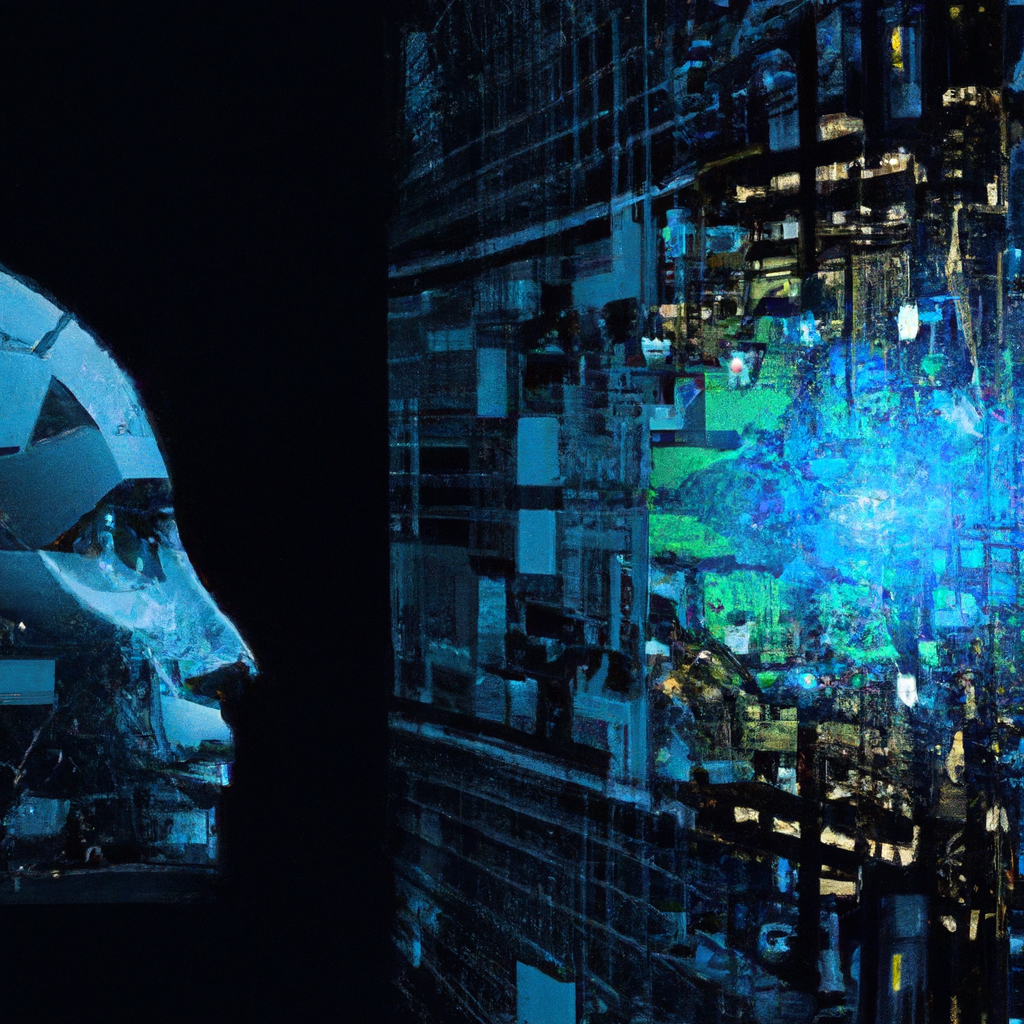Imagine a future where artificial intelligence (AI) plays a pivotal role in responding to and predicting natural disasters. It’s a concept that may seem like something out of a sci-fi movie, but the reality is that AI technology is already making significant strides in this field. With its ability to analyze vast amounts of data and make real-time decisions, AI has the potential to revolutionize disaster response efforts, ultimately saving countless lives and minimizing damage. But how exactly can AI help in disaster response and prediction? Let’s explore the possibilities and the impact this technology could have on our world.

Understanding AI in the Context of Disaster Management
Defining Artificial Intelligence (AI)
Artificial Intelligence (AI) refers to the simulation of human intelligence in machines that are programmed to think and learn like humans. It involves the development of computer systems capable of performing tasks that typically require human intelligence, such as speech recognition, problem-solving, decision-making, and data analysis. AI algorithms allow machines to process and interpret vast amounts of data, enabling them to identify patterns, predict outcomes, and make informed decisions.
The role of AI in disaster management
AI has the potential to revolutionize disaster management by improving prediction accuracy, optimizing response efforts, and enhancing overall effectiveness in disaster scenarios. With its ability to process and analyze massive amounts of data in real-time, AI can provide valuable insights and support decision-making processes during various stages of disaster management, from prediction and early warning to response and recovery.
Extent to which AI has been used in managing disasters
Though still in its early stages of implementation, AI has already been deployed in various disaster management initiatives around the world. From predicting earthquakes and hurricanes to optimizing emergency response efforts and aiding in post-disaster recovery, AI technologies are being leveraged to augment human capabilities and improve outcomes in disaster situations. While the full potential of AI in disaster management is yet to be realized, current advancements and ongoing research offer promising prospects for future applications.
AI in Disaster Prediction
How AI can improve accuracy in disaster prediction
By harnessing the power of AI, scientists and researchers are working towards improving the accuracy and efficiency of disaster prediction models. AI algorithms can analyze vast amounts of historical data, weather patterns, seismic activity, and other relevant information to identify trends and correlations that may go unnoticed by human analysts. With AI, disaster prediction models can be continuously refined and updated based on the latest data, leading to more accurate forecasts and early warnings.
Examples of AI tools in predicting natural disasters
AI-based tools and technologies have been developed to predict and monitor various natural disasters. For instance, machine learning algorithms can analyze satellite imagery and weather data to predict the path and intensity of hurricanes. Similarly, AI algorithms can analyze seismic data to identify patterns and predict the likelihood of earthquakes. These tools are valuable in providing early warnings, allowing authorities to take proactive measures and mitigate the impact of disasters.
Strengths and weaknesses of AI in disaster prediction
AI brings several strengths to the field of disaster prediction. Its ability to process large volumes of data and identify complex patterns can greatly enhance the accuracy of predictions. AI algorithms can also learn from real-time data and adapt their models accordingly, continuously improving their prediction capabilities. However, AI is not without its weaknesses. The accuracy of predictions depends heavily on the quality and availability of data, as well as the ability to accurately interpret complex patterns. Moreover, AI models may encounter challenges in predicting rare or unprecedented events, where historical data may be limited.
AI in Optimizing Disaster Response
Use of AI in real-time data gathering during disasters
During disaster events, the availability of real-time and accurate data is crucial for effective response. AI can play a significant role in optimizing data gathering and analysis processes. For example, AI-powered drones equipped with various sensors can collect data on disaster-affected areas, including terrain conditions, structural damage, and potentially trapped individuals. AI algorithms can then analyze this data, extract actionable insights, and provide real-time information to response teams, enabling them to make informed decisions and allocate resources efficiently.
Enhancing emergency response through AI
AI technologies can augment emergency response efforts by enabling faster and more accurate decision-making. By incorporating AI algorithms into emergency response systems, authorities can quickly process and analyze incoming data, such as emergency hotline calls, social media posts, and sensor data. AI can automatically categorize and prioritize these inputs, allowing response teams to focus on critical issues and efficiently allocate resources. Additionally, AI can help optimize route planning for emergency vehicles, ensuring they reach affected areas faster and more effectively.
Limitations of AI in disaster response
While AI can greatly enhance disaster response efforts, it is important to acknowledge its limitations. AI models rely on the availability and accuracy of data, which may be compromised or limited during a disaster. Furthermore, AI algorithms are only as effective as the data they are trained on, meaning that biases or errors in training data can impact their performance. Additionally, AI cannot replace human capabilities and expertise in complex decision-making processes, highlighting the need for collaboration between AI systems and human responders.
Case Studies of AI in Disaster Management
AI application in predicting and responding to earthquakes
In the field of earthquake prediction, AI has shown promising results. For example, scientists at Stanford University developed an AI algorithm that analyzed seismic waves to predict aftershock locations with greater accuracy than traditional methods. By training the algorithm on large seismic data sets, it was able to identify subtle patterns and precursors to aftershocks, enabling authorities to better prepare and respond to potential earthquakes. AI is also being used to monitor structural health in earthquake-prone areas, allowing for early detection of vulnerabilities and targeted pre-disaster interventions.
The use of AI in managing flood disasters
Floods pose significant challenges in disaster management, but AI can assist in various aspects of flood prediction, response, and recovery. For instance, AI algorithms can analyze weather patterns, rainfall data, and river levels to predict flood events and issue early warnings. AI-powered drones equipped with advanced sensors can gather real-time data on floodwater levels, infrastructure damage, and affected populations, providing valuable insights for emergency response teams. Additionally, AI can help optimize evacuation routes and allocate resources based on the evolving flood situation.
AI in responding to wildfires
Wildfires are becoming more frequent and severe, requiring efficient response strategies. AI can assist in detecting and predicting wildfires by analyzing satellite imagery, weather data, and other relevant information. For example, AI algorithms can identify areas with high vegetation stress, which can indicate potential wildfire risk. AI-powered drones and robots can also be deployed in fire-affected areas to gather real-time data, assess current fire behavior, and aid in firefighting efforts. Furthermore, AI can help coordinate the deployment of resources, such as fire engines and personnel, based on the dynamic nature of wildfires.

Future Prospects of AI in Disaster Management
AI innovations under development for disaster management
Researchers and innovators are continuously exploring new ways to leverage AI for disaster management. Some emerging areas of AI application include the use of machine learning algorithms for real-time flood mapping, AI-powered predictive models for disease outbreak management during disasters, and the integration of AI into early warning systems for various hazards. Additionally, advancements in robotics and automation are enhancing the capabilities of AI-enabled drones and robots, enabling them to navigate challenging terrains and perform complex tasks in disaster scenarios.
Potential impact of AI on disaster response and prediction
The potential impact of AI on disaster response and prediction is significant. Improved prediction accuracy can lead to better preparedness, timely evacuation of at-risk populations, and more efficient allocation of resources. Real-time data gathering and analysis through AI can enable faster response and better situational awareness for response teams. Additionally, AI can facilitate the integration of various data sources and enhance coordination among stakeholders involved in disaster management. The overall effectiveness of disaster management efforts can be greatly enhanced, leading to reduced loss of life and property.
Challenges for the future use of AI in disaster management
Despite its potential, the widespread use of AI in disaster management faces several challenges. One key challenge is the availability and quality of data. AI models require large amounts of diverse and accurate data to be trained effectively, but in many disaster-prone regions, such data may be limited or inaccessible. Additionally, ethical considerations related to data privacy and transparency must be addressed to ensure that the use of AI in disaster management respects the rights and dignity of affected individuals. Furthermore, the integration of AI into existing disaster management systems and workflows may require significant investment and capacity building.
AI and Climate Change-Related Disasters
How AI can predict climate change-induced disasters
As climate change continues to impact the frequency and severity of natural disasters, AI can play a crucial role in predicting and managing climate change-related hazards. AI algorithms can analyze climate data, historical records, and satellite imagery to identify patterns and trends associated with climate change-induced disasters. For example, AI can predict the likelihood of coastal flooding due to sea-level rise by analyzing tide and weather data. By providing early warnings and actionable insights, AI can help authorities and communities prepare for the impacts of climate change.
AI’s role in managing disaster risks due to climate change
AI can contribute to managing disaster risks by improving resilience and adaptation strategies in the face of climate change. For instance, AI algorithms can analyze climate and socioeconomic data to identify vulnerable areas and populations at risk of climate-related disasters. This information can inform urban planning, infrastructure development, and resource allocation to minimize the impact of disasters. Moreover, AI-powered sensors and monitoring systems can provide real-time data on climate parameters, informing decision-making and facilitating prompt response to changing environmental conditions.
Climate change and advancements in AI for disaster management
The intersection of climate change and advancements in AI presents opportunities for more effective and sustainable disaster management strategies. As AI continues to advance, it can contribute to climate modeling, allowing for better understanding and prediction of future climate scenarios. This knowledge can inform policy and decision-making processes, enabling proactive measures to mitigate climate-related risks. Additionally, AI can support the development of innovative solutions for climate change adaptation, such as smart grid systems, renewable energy optimization, and precision agriculture.

The Intersection of AI and Humanitarian Aid
Humanitarian applications of AI in disaster management
AI has the potential to greatly enhance humanitarian aid efforts in disaster management. For example, AI algorithms can analyze social media posts to identify and prioritize requests for help during disasters, facilitating efficient resource allocation. AI-powered chatbots and virtual assistants can provide real-time information and support to affected individuals, reducing their reliance on scarce human resources. Furthermore, AI can assist in data analysis and decision-making processes for humanitarian organizations, improving their capacity to plan and respond effectively in disaster situations.
How AI can enhance the effectiveness of humanitarian actions in a disaster
By leveraging AI technologies, humanitarian actions can be more targeted, efficient, and timely. Real-time data analysis through AI can help identify the most affected areas and vulnerable populations, enabling humanitarian organizations to allocate resources and assistance where they are most needed. AI-powered translation tools can bridge language barriers, facilitating effective communication and coordination in diverse disaster-affected regions. Moreover, AI can assist in post-disaster recovery efforts by analyzing satellite imagery to assess damage and support reconstruction planning.
Ethical considerations when using AI in humanitarian response
While AI holds immense potential for humanitarian aid, it is crucial to consider ethical implications when deploying AI technologies in disaster response. Privacy and data protection concerns must be addressed to ensure the responsible use of personal data for humanitarian purposes. Transparency in AI algorithms and decision-making processes is essential to ensure accountability and avoid bias. Humanitarian organizations must also ensure that the use of AI complements and respects the skills and expertise of humanitarian workers, rather than replacing them.
Government Use of AI in Disaster Management
Examples of governmental use of AI in disaster prediction and response
Governments around the world are increasingly harnessing AI technologies to improve their disaster prediction and response strategies. For instance, the Japanese government utilizes AI technologies to analyze seismic data and issue early warnings for earthquakes. In the United States, the Federal Emergency Management Agency (FEMA) uses AI algorithms to analyze diverse data sources and assess disaster impacts, aiding in response planning and resource allocation. Similarly, the Australian government employs AI-powered predictive models to forecast bushfire behavior and optimize firefighting efforts.
Challenges governments face when implementing AI in disaster response strategies
The implementation of AI in government disaster response strategies brings forth several challenges. Governments must invest in the necessary infrastructure and technology to collect, analyze, and disseminate vast amounts of data in real-time. Additionally, building the capacity of personnel to understand and effectively utilize AI technologies is essential. Moreover, interoperability and data sharing among different government agencies and stakeholders can be complex, requiring collaboration and coordination. Ethical considerations, such as accountability and transparency, also come into play when deploying AI in government disaster management.
Possible policy implications for widespread government adoption of AI for disaster response and prediction
Widespread government adoption of AI for disaster response and prediction calls for the development of appropriate policies and regulations. Governments must establish frameworks for data governance, ensuring the responsible collection, storage, and use of data in line with privacy and security standards. Transparency and explainability standards should be set to ensure public trust and avoid potential biases in AI algorithms. Additionally, collaboration and information sharing between governments at the national and international levels can improve the effectiveness of AI in disaster management.

Private Sector Involvement in AI for Disaster Management
Role of tech companies in developing AI for disaster response
Tech companies play a critical role in developing and implementing AI technologies for disaster management. Companies specializing in AI and data analytics develop advanced algorithms and tools that can process and analyze massive amounts of data in real-time. These technologies enable governments and humanitarian organizations to harness the power of AI for improved disaster prediction, response, and recovery. Tech companies also contribute to innovation by collaborating with researchers, sharing expertise, and investing in AI research and development.
Collaborative efforts between private sector and government in AI and disaster management
Collaboration between the private sector and government is crucial for the effective utilization of AI in disaster management. Governments provide the regulatory framework, infrastructure, and access to data, while private sector companies bring in the expertise, investment, and technological capabilities. Public-private partnerships can facilitate knowledge exchange, data sharing, and joint research and development efforts. Such collaborations can result in innovative solutions, improved data availability, and enhanced coordination among stakeholders involved in disaster management.
Economic implications of private sector involvement in AI for disaster response
The private sector’s involvement in AI for disaster response has significant economic implications. Investments by tech companies in AI research and development stimulate economic growth and innovation. AI technologies can enhance the efficiency and effectiveness of disaster response, potentially reducing the economic impact of disasters. Additionally, private sector companies offering AI-based products and services for disaster management create new market opportunities and job prospects. However, careful consideration must be given to ensure equitable access to AI technologies and prevent the exacerbation of existing inequalities.
Evaluating the Effectiveness of AI in Disaster Management
Existing research on AI’s effectiveness in disaster response and prediction
There is a growing body of research exploring the effectiveness of AI in disaster response and prediction. Studies have demonstrated the improved accuracy of AI algorithms in predicting earthquakes, hurricanes, and other natural disasters compared to traditional methods. Research has also highlighted the speed and efficiency gains achieved through the integration of AI into emergency response systems. Additionally, case studies and simulations have demonstrated the potential impact of AI technologies in improving decision-making and resource allocation during disaster scenarios.
Methods for evaluating AI’s performance in disaster scenarios
Evaluating the performance of AI technologies in disaster scenarios requires robust methodologies and frameworks. Metrics such as prediction accuracy, response time, and resource optimization can be used to assess the effectiveness of AI algorithms and systems. Comparative studies between AI-based approaches and traditional methods can provide insights into the added value of AI in disaster management. Real-world simulations and controlled experiments can also be conducted to evaluate the usability, reliability, and safety of AI technologies in realistic disaster scenarios.
Implications of AI effectiveness in disaster management for future developments
The effectiveness of AI in disaster management has significant implications for future developments. Positive results from research and real-world applications can inform the design and implementation of AI technologies in disaster response and prediction. Lessons learned from evaluating the performance of AI algorithms and systems can guide improvements and refinements in future iterations. Additionally, the effectiveness of AI technologies can influence policy-making and funding decisions, encouraging further investment and collaboration in the development and deployment of AI for disaster management.











